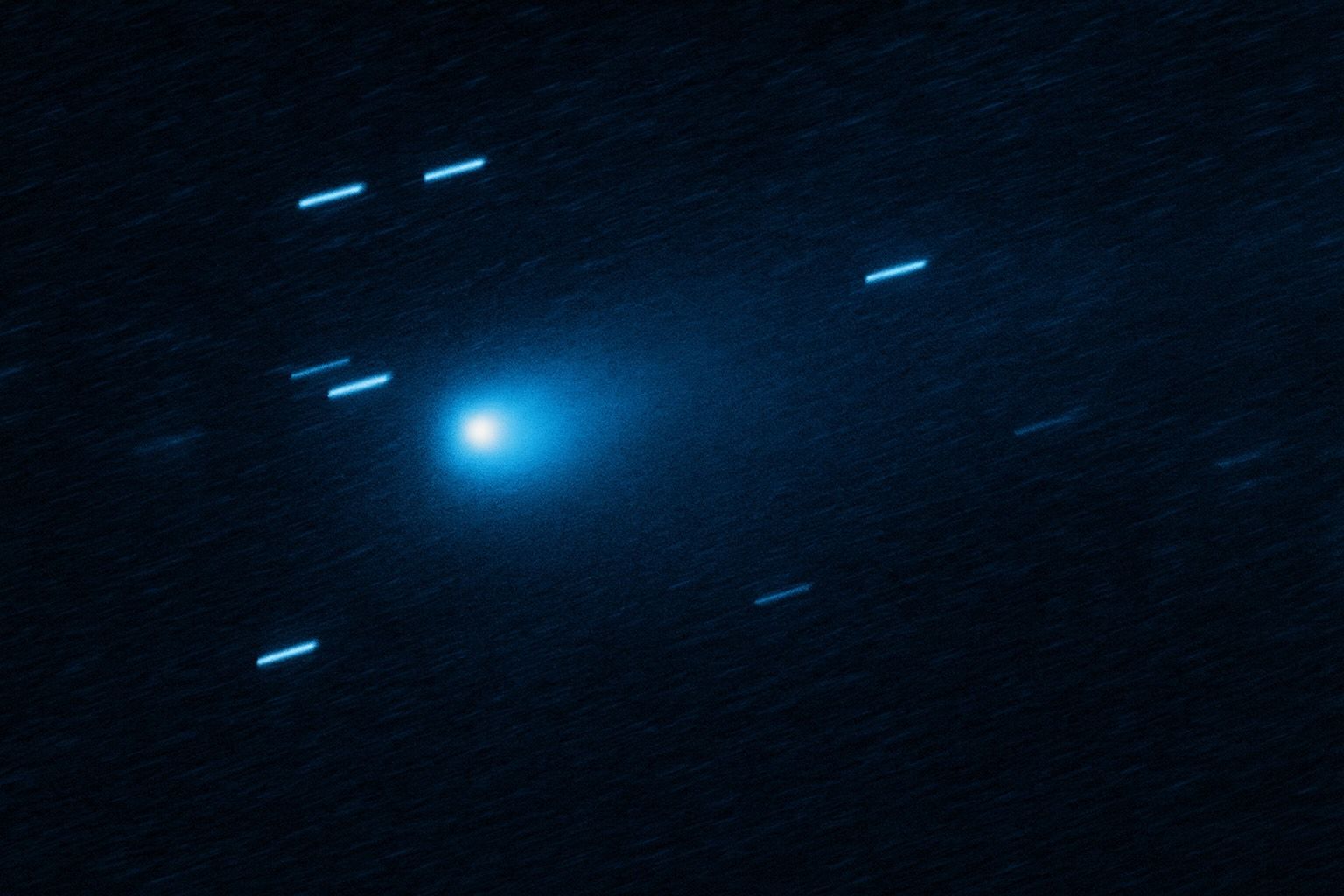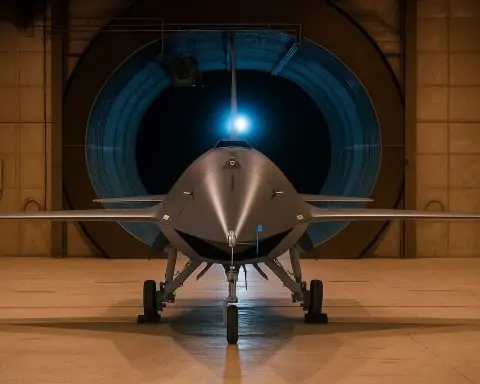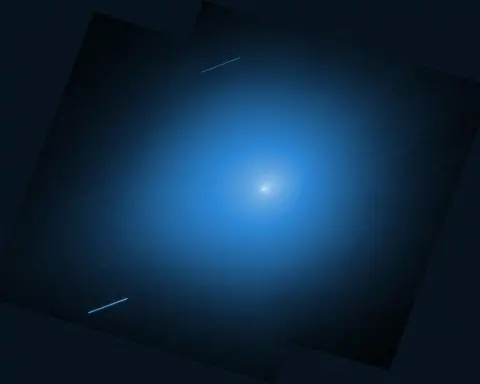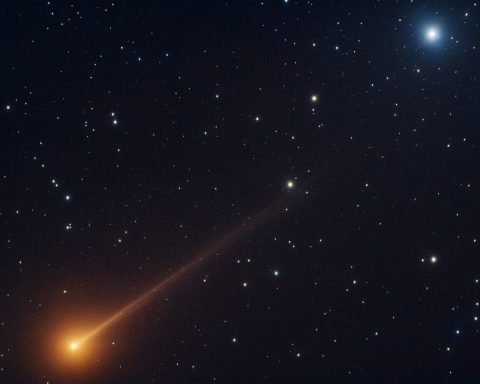- Third known interstellar visitor: Comet 3I/ATLAS (C/2025 N1) was discovered on July 1, 2025 by the ATLAS survey in Chile. It is only the third object confirmed to enter our Solar System from interstellar space, after 1I/‘Oumuamua (2017) and 2I/Borisov (2019) [1]. A hyperbolic orbit (eccentricity ≈6.14) and ~210,000 km/h speed confirm it’s unbound to the Sun [2], meaning this comet is on a one-way trip and will never return.
- Mars flyby captured on camera: In early October 2025, 3I/ATLAS passed about 30 million km from Mars – giving ESA’s ExoMars TGO and Mars Express orbiters the best view yet of an interstellar comet [3] [4]. Images from Oct 3 show a faint fuzzy dot (the comet’s coma) moving against background stars [5] [6]. The comet was extremely dim – “around 10,000 to 100,000 times fainter than our usual target,” noted Dr. Nick Thomas, the CaSSIS camera lead [7] – making this observation a major technical challenge.
- Ancient cosmic “time capsule”: Based on its trajectory and makeup, 3I/ATLAS is incredibly old. Astronomers suspect it may be on the order of 3 billion years older than our 4.6 billion-year-old Solar System [8]. One team estimates the comet formed roughly 7 billion years ago, making it potentially the oldest comet ever observed [9]. In other words, this object likely condensed in a primordial planetary system long before Earth existed – a frozen time capsule from the early Milky Way [10] [11].
- Big and carbon-rich: Telescopes reveal 3I/ATLAS has a substantial nucleus (estimated up to ~5–6 km across) – far larger than ‘Oumuamua (≲0.4 km) or Borisov (~1 km) [12] [13]. Its mass is likewise enormous: on the order of 33 billion tons [14] [15]. Spectroscopic studies by JWST and other observatories found an unusual composition, rich in carbon dioxide (CO₂) and water ice but very low in carbon monoxide (CO) [16] [17]. The CO₂-to-H₂O ratio (~8:1) is one of the highest ever seen in a comet [18], suggesting 3I/ATLAS formed in a carbon-rich region of its home system (or was “baked” by heat that drove off CO) [19] [20]. This chemical makeup is giving scientists unique clues to the comet’s origin beyond our Solar System.
- Scientists racing to study it: Unlike prior interstellar visitors, 3I/ATLAS is behaving like a normal comet – actively venting gas and dust that can be analyzed [21] [22]. This offers an unprecedented opportunity to sample materials from another star. Dozens of instruments are tracking it: Hubble imaged a teardrop-shaped coma and dust tail as early as July [23] [24], JWST and the new SPHEREx telescope detected the CO₂ “fog” in its coma [25] [26], and even NASA’s Perseverance rover on Mars may have spotted it in the sky [27]. After its Mars-adjacent flyby (Oct 1–7), scientists are stacking Mars Express images to tease out the faint object [28] [29]. In November, ESA’s Juice probe will observe 3I/ATLAS just after it slings around the Sun (perihelion in late October) [30] [31], when the comet is most active. Researchers hope to learn the comet’s exact composition and behavior as it heats up [32] [33].
- No threat – and no aliens: 3I/ATLAS poses zero danger to Earth. It will not come closer than ~1.8 AU(270 million km) from our planet [34] [35] – a distant flyby well beyond Mars’s orbit. NASA emphasizes the comet’s trajectory is a “benign flight path” with no risk of impact [36] [37]. (For scale, its closest approach to Earth is over 1.5 times the Earth–Sun distance [38] [39].) The public fascination has nevertheless spawned wild speculation – including unproven “alien spacecraft” theories. Notably, Prof. Avi Loeb pointed out the comet’s orbit happens to align with the plane of our planets and even came from near the “Wow! Signal” sky region, hinting at a possible artificial origin [40] [41]. Most experts strongly disagree: 3I/ATLAS “looks like a comet and it behaves like a comet” with no signs of technology, stresses ESA scientist Dr. Michael Küppers [42]. Both NASA and ESA have publicly debunked doomsday and alien rumors, reiterating that 3I/ATLAS is natural and an extraordinary scientific opportunity [43] [44].
A Visitor from Beyond the Solar System
Humanity has waited a long time to study a comet from another star – and suddenly, within a decade, we’ve had three. 3I/ATLAS (officially 3I/2025 A1) is the latest of these rare interstellar interlopers. It was first detected moving through the outer Solar System in June 2025 with an exceptionally eccentric orbit. Follow-up observations quickly confirmed what its speed and trajectory implied: this object was not bound to the Sun’s gravity [45]. By July 2025, the Minor Planet Center designated it the third interstellar object ever found [46]. Like its predecessors – the cigar-shaped 1I/‘Oumuamua and cometary 2I/Borisov – 3I/ATLAS is an outsider: it originated around a distant star and is merely passing through our cosmic neighborhood [47].
What makes 3I/ATLAS especially exciting is that it’s the most “comet-like” interstellar visitor so far. ‘Oumuamua was puzzlingly inert (no coma or tail observed) and Borisov, while clearly a comet, never came very close to the Sun [48]. In contrast, 3I/ATLAS is big, bright, and active, venting gas and dust as it approaches the Sun [49] [50]. “You wait ages for an interstellar comet to arrive and then three come along at once,” joked science writer Ian Sample [51] – but 3I/ATLAS might be the one that truly opens a window onto other worlds. As Dr. Michael Küppers (ESA’s Comet Interceptor project scientist) explains, “these objects are the first building blocks we can observe from [other stellar] systems… They tell us about the conditions in the stellar system where they formed.” [52] Studying 3I/ATLAS up close lets scientists test theories about planet formation beyond our Solar System that, until now, were purely speculative [53].
A Closer Look at 3I/ATLAS
Size & mass: Preliminary data suggested 3I/ATLAS was unusually large – a fact now borne out by Hubble and other observations. By analyzing the dust halo in Hubble images, astronomers constrained the comet’s solid nucleus to be between a few hundred meters and ~5.6 km in diameter [54] [55]. In other words, it could be as small as a skyscraper or as wide as a city, but likely a few kilometers across. That makes it possibly the largest interstellar object ever seen [56] [57]. For comparison, Borisov’s core was ~1 km, and ‘Oumuamua was at most 400 m long [58]. Astronomers estimate 3I/ATLAS’s mass exceeds 3×10^10 tons (tens of billions of tons) [59] [60] – on the same order as some of Earth’s biggest mountains. This “Manhattan-sized” mass is derived from its observed outgassing and trajectory changes [61] [62]. “Far larger than the previous two interstellar visitors,” one study noted of 3I/ATLAS’s bulk [63].
Trajectory & distance: 3I/ATLAS’s path is a hyperbolic swing through the inner Solar System. It approached from the direction of the constellation Sagittarius [64] and entered roughly along the ecliptic plane (the plane of the planets’ orbits). In late September 2025 it disappeared behind the Sun from Earth’s viewpoint [65], then on October 3 it made its closest approach to Mars, at ~30 million km. Although distant by human standards, this was a fortuitous alignment – Mars happened to be in the right place to give its orbiters a front-row seat [66] [67]. The closest approach to the Sun (perihelion) will occur around Oct 29–30, 2025, at roughly 1.4 AU (210 million km) from the Sun [68] [69] – just inside Mars’s average orbit. After that, 3I/ATLAS will head back out toward interstellar space, crossing Jupiter’s orbit by March 2026 on its way out of the Solar System [70] [71]. Closest to Earth? It won’t come anywhere near us – no closer than 1.7–1.8 AU (over 250 million km) away at minimum [72] [73]. For context, that’s more than 600 times the Earth–Moon distance. As NASA put it, 3I/ATLAS is a “remote cosmic flyby with no risk of impact.” [74] [75]
Carbon-rich coma: Perhaps the most intriguing findings about 3I/ATLAS involve its chemical composition. In August and September 2025, teams around the world trained advanced telescopes on the comet’s coma (its thin atmosphere of sublimated ice and dust). NASA’s brand-new SPHEREx space telescope – designed to survey cosmic ices – made a headline discovery: a huge cloud of carbon dioxide gas enveloping 3I/ATLAS [76] [77]. The CO₂ coma was detected out to a radius of ~348,000 km from the nucleus [78], nearly the Earth–Moon distance, indicating copious CO₂ venting. At the same time, spectral data from SPHEREx and JWST found plenty of H₂O (water ice) signatures in the nucleus, but a surprising dearth of carbon monoxide (CO) gas [79] [80]. According to Johns Hopkins University scientist Dr. Carey Lisse, the unusually high CO₂/H₂O ratio – roughly 8:1 by some measures – suggests 3I/ATLAS “was well baked and boiled” before it was kicked out of its home system [81] [82]. In other words, it likely formed in a relatively warm, carbon-rich disk (closer to its star, where CO ice was scarce or got depleted) [83] [84]. This composition “closely resembles [comets in] our own solar system” in terms of major ingredients [85] [86], indicating that planetary systems elsewhere can produce very similar ice-rich bodies. But the extreme CO₂ dominance also hints that 3I/ATLAS might hail from a different kind of environment than typical Oort Cloud comets here [87] [88]. Researchers are eagerly comparing these ratios to those of known comets to pin down how and where this interstellar wanderer was born.
“A Window into the Universe’s Past”
Every scrap of data from 3I/ATLAS is precious, because it carries interstellar memories. As Oxford astronomer Matthew Hopkins remarked, “this is an object from a part of the galaxy we’ve never seen up close before.” [89]Indeed, if 3I/ATLAS is ~7–10 billion years old, it could be a survivor from the earliest generation of planetary systems [90] [91]. By studying its composition and structure, scientists hope to learn how planets and comets formed around other stars eons ago. “What makes 3I/ATLAS unique is that it allows us to study the evolution of objects from other stellar systems – something we had only theorized until now,” said Dr. Fernando Pérez Couto, who led a recent orbital tracing study of the comet. “Each observation is like opening a window into the Universe’s past.” [92]
So far, 3I/ATLAS’s origin star system remains unknown. Astronomers tried reconstructing its past trajectory through the Milky Way using ESA’s Gaia star catalog: they simulated millions of years backward to see if 3I/ATLAS passed near any known stars [93] [94]. The result? Dozens of small flybys, but no clear “home star” within the last 10 million years [95] [96]. In fact, nothing in that timeframe significantly perturbed its path [97]. This suggests 3I/ATLAS might have been drifting in the galaxy for aeons largely unbothered – perhaps originating from the galaxy’s thin disk (the flatter plane of newer stars), according to the Spanish team’s preliminary analysis [98]. An earlier idea had posited a thick disk origin (an older stellar population) given the object’s extreme age, but the new orbit mapping favors a thin-disk trajectory [99]. In any case, pinpointing the exact stellar nursery of 3I/ATLAS may be impossible. The comet’s billions of years of travel could mean its parent star has moved or died, or the comet was tossed around by multiple star encounters. It truly is a mystery messenger from parts unknown.
Mars Flyby: A Rare Photo Opportunity
As 3I/ATLAS zoomed through the inner Solar System, planetary spacecraft offered a unique perspective. Between October 1–7, 2025, ESA instructed its Trace Gas Orbiter (TGO) and Mars Express – both orbiting Mars – to turn their cameras toward the incoming comet [100]. This was the first time we’ve attempted to photograph an interstellar comet from another planet’s vicinity. During the closest approach on October 3, when 3I/ATLAS was ~30 million km from Mars, each orbiter snapped multiple images [101] [102]. Given the instruments were designed to image Mars’s bright surface just a few hundred km below, spotting a dim comet so far away was “very challenging” [103]. In the TGO photos (compiled into a short GIF), 3I/ATLAS appears as a tiny smudge of light drifting against the black of space [104]. That smudge is essentially the comet’s coma – a dust-and-gas cloud a few thousand kilometers wide, which the orbiter cameras could just barely resolve as a fuzzy dot [105]. The nucleus itself was far too small and distant to distinguish (imaging a ~5 km object from 30 million km is like trying to see a cellphone from Earth’s distance to the Moon) [106]. Still, the fact it was visible at all is a testament to the comet’s activity and the sensitivity of the cameras. “The comet is around 10,000 to 100,000 times fainter than our usual target,” Dr. Nick Thomas noted, “so we weren’t sure what to expect.” [107] The Mars orbiters could clearly detect the coma and perhaps a hint of the developing tail, although the tail was too faint to resolve in these initial images [108].
On the Mars Express orbiter, initial images did not show the comet (exposure was limited to 0.5 s, too short to pick up such a dim object) [109]. But mission scientists are now combining multiple shots to boost the signal, hoping to reveal 3I/ATLAS in the data [110] [111]. Both orbiters also attempted to collect spectra of the comet’s coma – using Mars Express’s OMEGA and SPICAM spectrometers and TGO’s NOMAD instrument [112]. It’s uncertain if those spectrometers caught anything (the comet’s gas may have been below detection thresholds) [113], but if they did, it could complement the Webb and SPHEREx findings with additional chemical details. “Our Mars orbiters usually focus on Mars, but it’s extra exciting to see them respond to unexpected situations like this,” said ESA’s Colin Wilson, “I look forward to seeing what the data reveals.” [114]
Even NASA’s Perseverance rover tried its hand at interstellar comet-spotting. In late September, while Mars was on the night side, Perseverance pointed its cameras upward. There’s a chance it caught a glimpse of 3I/ATLAS from the Martian surface – a faint moving star-like point [115]. If so, it would be the first time a rover on another planet observed a visitor from another star. Those images are still being analyzed.
What’s Next for 3I/ATLAS?
The cosmic show isn’t over. Late October 2025 is when 3I/ATLAS reaches perihelion (closest approach to the Sun), and it’s expected to brighten further as solar heating peaks [116]. Unfortunately, from Earth we won’t be able to see it then – it will be lost in the Sun’s glare throughout October and much of November [117]. However, once it swings around to the other side of the Sun, the comet should re-emerge in late November or early December 2025 [118]. Ground-based telescopes are gearing up for that window, which will likely be the last chance to observe 3I/ATLAS before it fades away for good. Even at its brightest, this comet won’t be a naked-eye spectacle; at best it may reach about magnitude 12 – requiring an amateur telescope to spot [119]. Still, professional observatories worldwide (and even some well-equipped amateurs) will be watching, gathering every photon of data possible.
Importantly, spacecraft observations continue. In November 2025, ESA’s JUICE (Jupiter Icy Moons Explorer) will attempt to observe 3I/ATLAS [120]. JUICE won’t get nearly as close as the Mars orbiters did – it will be tens of millions of kilometers away – but the timing is key. JUICE will view the comet just after perihelion, when 3I/ATLAS is “in a more active state” (freshly heated by the Sun) [121]. Scientists anticipate JUICE’s instruments could detect changes in the comet’s activity post-sunflyby, and perhaps gather spectra or imagery from a unique vantage point. However, patience is required: due to data downlink constraints, ESA doesn’t expect to receive JUICE’s comet observations until February 2026 [122].
Looking farther ahead, the excitement around 3I/ATLAS is a proof of concept for future missions. ESA is already preparing a mission called Comet Interceptor – due to launch in 2029 – which will lie in wait at a stable point in space, ready to sprint toward an intruding comet [123] [124]. The idea is to have a spacecraft on standby that can intercept a fresh comet (ideally one from the distant Oort Cloud, or even an interstellar object) on short notice [125] [126]. “When Comet Interceptor was selected in 2019, we only knew of one interstellar object,” Dr. Küppers noted. “Since then, two more such objects have been discovered, showing large diversity in their appearance. Visiting one could provide a breakthrough in understanding their nature.” [127] While it’s still unlikely we’ll find an interstellar target that conveniently passes near Comet Interceptor’s location, the mission will test our ability to react quickly to unexpected visitors [128] [129]. Many scientists believe that as sky surveys improve (with new facilities like the Vera Rubin Observatory coming online), we will detect more interstellar objects in the coming years [130] [131]. The count is already three in eight years – who knows, by the 2030s we might be finding these cosmic nomads regularly. Each discovery offers a new sample of material from another star, and potentially, as our technology advances, a target for close-up exploration.
Broader Impact and Outlook
The discovery and study of 3I/ATLAS underscore how rapidly our capabilities in astronomy are growing – and how international collaboration can seize fleeting opportunities. In just a few months, scientists marshaled ground observatories, space telescopes, and interplanetary probes to investigate this one comet. The science returns are enormous: we’ve learned that comets from another star can closely resemble those in our own Solar System (rich in water and CO₂) [132] [133], yet they can carry subtle chemical fingerprints (like missing CO or unusual metal ratios) that hint at different cosmic origins [134] [135]. We’ve witnessed an interstellar object become “alive” as it nears our Sun, sprouting a coma and tail that we can analyze in real time [136] [137]. And we’ve shown that even decades-old spacecraft at Mars can be repurposed to capture a once-in-a-lifetime event [138] [139].
This kind of scientific excitement is also a public inspiration. Interest in 3I/ATLAS has been feverish – from social media speculation to mainstream news headlines – highlighting humanity’s enduring fascination with the possibility of life or messages from the stars. While 3I/ATLAS is almost certainly just a comet, not an alien craft, it fires the imagination and reminds us how much of the cosmos we have yet to explore. Already, some investors and space industries are taking note of the growing focus on interstellar and deep-space exploration. Major aerospace contractors that build spacecraft and telescopes have steady support as these missions multiply. For instance, Lockheed Martin – which partners on numerous NASA/ESA projects – saw its stock trading around $513 per share in early October 2025 [140]. Similarly, Northrop Grumman, builder of instruments like the JWST, traded near $634 at that time [141]. These stable valuations reflect confidence that the appetite for space science will continue, translating into contracts for advanced missions. While a comet passing by Mars doesn’t itself move markets, the implications of such discoveries – new missions, technologies, and perhaps one day resource utilization or defense – bolster the long-term outlook for the space sector.
Ultimately, comet 3I/ATLAS is a fleeting visitor – by early 2026 it will vanish into the darkness, bound for the stars from whence it came. But for a brief moment, it has forged a connection between us and a far-off corner of the galaxy. “Each observation is like opening a window into the Universe’s past,” as one researcher put it [142]. The data gathered will keep scientists busy for years, piecing together the story of this ancient wanderer. And as we prepare for the next interstellar arrivals, we do so with a sense of excitement and curiosity that bridges science and the public sphere alike. 3I/ATLAS has shown us that the void between the stars is not empty – it’s teeming with remnants of other worlds, occasionally delivered to our cosmic doorstep. Who knows what the next one will teach us?
Sources: Interstellar comet coverage by IFLScience [143] [144]; European Space Agency news [145] [146]; ABC News [147] [148]; CBS News [149] [150]; The Guardian [151] [152]; Tech Space 2.0 (ts2.tech) analyses [153] [154]; and NASA/ESA scientific releases.
References
1. ts2.tech, 2. ts2.tech, 3. www.esa.int, 4. www.esa.int, 5. www.esa.int, 6. www.esa.int, 7. www.cbsnews.com, 8. www.esa.int, 9. ts2.tech, 10. www.iflscience.com, 11. www.iflscience.com, 12. www.theguardian.com, 13. www.theguardian.com, 14. abcnews.go.com, 15. abcnews.go.com, 16. abcnews.go.com, 17. ts2.tech, 18. ts2.tech, 19. ts2.tech, 20. ts2.tech, 21. ts2.tech, 22. ts2.tech, 23. ts2.tech, 24. ts2.tech, 25. ts2.tech, 26. ts2.tech, 27. www.iflscience.com, 28. www.esa.int, 29. www.esa.int, 30. abcnews.go.com, 31. www.esa.int, 32. abcnews.go.com, 33. www.esa.int, 34. ts2.tech, 35. ts2.tech, 36. ts2.tech, 37. ts2.tech, 38. www.theguardian.com, 39. ts2.tech, 40. www.theguardian.com, 41. www.theguardian.com, 42. www.theguardian.com, 43. ts2.tech, 44. ts2.tech, 45. ts2.tech, 46. ts2.tech, 47. www.esa.int, 48. www.theguardian.com, 49. ts2.tech, 50. ts2.tech, 51. www.theguardian.com, 52. www.theguardian.com, 53. www.iflscience.com, 54. www.theguardian.com, 55. ts2.tech, 56. www.theguardian.com, 57. ts2.tech, 58. www.theguardian.com, 59. abcnews.go.com, 60. ts2.tech, 61. abcnews.go.com, 62. abcnews.go.com, 63. ts2.tech, 64. ts2.tech, 65. www.cbsnews.com, 66. www.esa.int, 67. www.esa.int, 68. ts2.tech, 69. ts2.tech, 70. ts2.tech, 71. ts2.tech, 72. ts2.tech, 73. ts2.tech, 74. ts2.tech, 75. ts2.tech, 76. ts2.tech, 77. ts2.tech, 78. ts2.tech, 79. ts2.tech, 80. ts2.tech, 81. ts2.tech, 82. ts2.tech, 83. ts2.tech, 84. ts2.tech, 85. ts2.tech, 86. ts2.tech, 87. ts2.tech, 88. ts2.tech, 89. ts2.tech, 90. www.esa.int, 91. ts2.tech, 92. www.iflscience.com, 93. www.iflscience.com, 94. www.iflscience.com, 95. www.iflscience.com, 96. www.iflscience.com, 97. www.iflscience.com, 98. www.iflscience.com, 99. www.iflscience.com, 100. www.esa.int, 101. www.esa.int, 102. www.esa.int, 103. www.cbsnews.com, 104. www.esa.int, 105. www.esa.int, 106. www.esa.int, 107. www.cbsnews.com, 108. www.esa.int, 109. www.esa.int, 110. www.esa.int, 111. www.esa.int, 112. www.esa.int, 113. www.esa.int, 114. abcnews.go.com, 115. www.iflscience.com, 116. www.cbsnews.com, 117. www.cbsnews.com, 118. www.cbsnews.com, 119. ts2.tech, 120. www.esa.int, 121. www.esa.int, 122. www.esa.int, 123. www.esa.int, 124. www.esa.int, 125. www.esa.int, 126. www.esa.int, 127. www.esa.int, 128. www.esa.int, 129. www.esa.int, 130. www.esa.int, 131. www.esa.int, 132. ts2.tech, 133. ts2.tech, 134. www.theguardian.com, 135. www.theguardian.com, 136. ts2.tech, 137. ts2.tech, 138. www.esa.int, 139. www.esa.int, 140. www.investing.com, 141. www.investing.com, 142. www.iflscience.com, 143. www.iflscience.com, 144. www.iflscience.com, 145. www.esa.int, 146. www.esa.int, 147. abcnews.go.com, 148. abcnews.go.com, 149. www.cbsnews.com, 150. www.cbsnews.com, 151. www.theguardian.com, 152. www.theguardian.com, 153. ts2.tech, 154. ts2.tech









